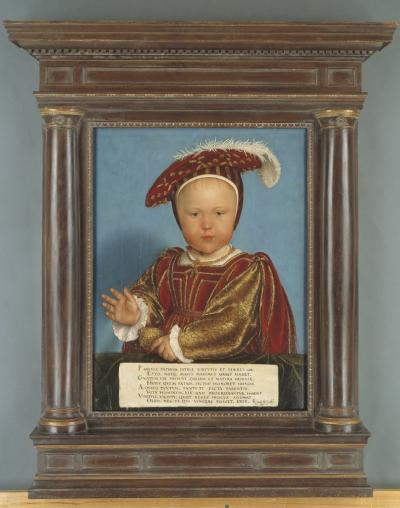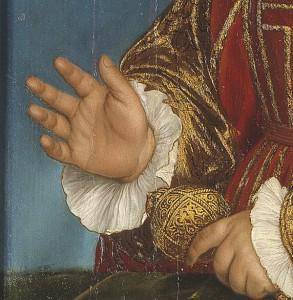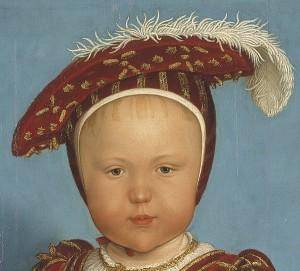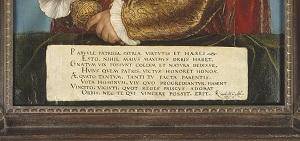
Edward, Prince of Wales (later King Edward VI)
Hans Holbein the Younger and Studio, Germany
1538
22.75 in. x 17 in.
Long-term loan from the Berger Collection, TL-17310
Photograph © Denver Art Museum 2009. All Rights Reserved.
Hans Holbein [HOLE-bine] the Younger was born in Augsburg, Germany, and is considered the most important portrait painter in England during the Reformation, a time when Christian ideals changed greatly. His father, Hans Holbein the Elder, was also an artist and gave Holbein his first art lessons. Holbein married and lived as an adult in Basel, Switzerland, but as the Protestant Reformation grew and religious images were being smashed and burned, it became increasingly difficult to succeed as an artist. Holbein moved to England, where his reputation for highly skilled and dignified portraiture preceded him, and he became the official painter to King Henry VIII beginning in 1536. In addition to painting royal portraits, he also traveled in Europe with a writer, assigned the unwelcome task of returning with portraits and written descriptions of potential brides for the king, to whom attractiveness was highly important. Through his meticulous technique, Holbein achieved remarkable realism in details and, despite his emotional remove, some sense of individual character. He died of plague in his forties, but his artistic influence was significant—English portraits were patterned on his style for almost a century after his death.
Prince Edward was about 14 months old when Holbein painted this portrait of him. Edward was born to Jane Seymour, the third wife of Henry VIII, in 1537. When she died two weeks after giving birth, King Henry was devastated. In addition to getting all of his father’s affection, the prince received a rigorous education and carried the weight of his father’s expectations for him to succeed him on the throne and champion his cause of consolidating the Reformation. Though he was a frail child with weak eyesight and periodic deafness, he appears healthy and robust in his portraits. Edward was nine years old when he was crowned King of England and Ireland after his father’s death. Although guided by a council of advisors, Edward showed strong interest in religious policy, and just as his father had hoped, his reign furthered his father’s cause. Edward’s accomplishments were cut short, though, when he died of tuberculosis at the age of 15.
Details

Pose
Holbein’s challenge was to make a baby look like a king. Prince Edward sits up straight, looking down slightly at the viewer, and holds his hand up in an intelligent gesture of speaking, of benediction (like a bishop or Christ himself), or perhaps acknowledging the cheers of his adoring subjects. The young boy holds a golden rattle in his left hand, like the scepter he’s expected to hold one day. His control of his arms and head make him seem older.

Fancy Clothes
Prince Edward is dressed in a very formal adult-like outfit. He is wearing a red velvet tunic and a fancy hat tied under his chin, both of which have elaborate gold details. The detail on his gold brocade sleeves shows off the artist’s impressive control of his paintbrush.

Setting
Holbein has placed Prince Edward behind a parapet draped with a dark green cloth. This separates the space between the royal child and the viewer, and also creates the perfect spot to place an inscription.

The Inscription
The inscription at the bottom of the painting is a poem in Latin written by Sir Richard Morison. Translation:
Little one, emulate thy father and be the heir of his virtue; the world contains nothing greater. Heaven and earth could scarcely produce a son whose glory would surpass that of a father. Do thou but equal the deeds of thy parent, and men can ask no more. Shouldst thou surpass him, thou has outstript all, nor shall any surpass thee in ages to come.
Such inscriptions were not uncommon, especially for royal paintings like this one. The King commissioned the portrait not just to have a likeness of his son, but also to serve propaganda purposes, promoting his royal dynasty and his causes. The words flatter the king, communicate his power, and lend validity to his Reformation causes. They also convey the high expectations held for the child.

Ostrich Feather
The curve of the white ostrich feather that tops the boy’s hat complements the gesture young Edward makes with his right hand, creating balance in the composition.

Shadow
The shadow cast by the young boy onto the blue background creates a sense of real space.

Faded Indigo
The dark blue bands that line the sides of this painting indicate that the image is not displayed in its original frame. Indigo pigment fades in light, meaning those darker areas were once covered by a frame of slightly narrower dimensions. The dark blue areas show the original background color.
More Resources
Websites
Berger Collection Educational Trust
The Berger Collection website provides information about Edward, Prince of Wales.
Books
Standring, Timothy J. 600 Years of British Painting: The Berger Collection. Denver, CO: The Denver Art Museum in association with the W.M.B Berger Charitable Trust, 1998.
An exhibition catalogue from the Denver Art Museum. Pages 38-39 discuss this painting.
Blizzard, Gladys S. Come Look With Me: Enjoying Art with Children. Watertown, MA: Charlesbridge Publishing, 1996.
A book containing images of 12 different works of art, including Hans Holbein the Younger’s Edward, Prince of Wales, paired with thought-provoking questions that encourage children to explore the piece.
Buck, Stephanie, and Jochen Sander. Hans Holbein the Younger: Painter at the Court of Henry VIII. London: Thames and Hudson, 2004.
A discussion of Hans Holbein the Younger and his role in the court of Henry VIII.
Michael, Erika. Hans Holbein the Younger: A Guide to Research. New York City: Routledge, 1997.
An annotated bibliography of research sources about the artist.
Piper, David, ed. The Genius of British Painting. New York: William Morrow & Company, Inc., 1975.
A discussion of Hans Holbein the Younger’s role in the history of Tudor painting. See pages 62-85 for this information.
Roberts, Jane. Drawings by Holbein from the Court of Henry VIII. Orlando, FL: Harcourt Brace Corporation, 1987.
An exhibition catalogue created by the Museum of Fine Arts in Houston which includes information about the artist as well as the reign of Henry VIII. Page 86 discusses the twin painting to Edward, Prince of Wales, located in Washington D.C.
Funding for object education resources provided by a grant from the Morgridge Family Foundation. Additional funding provided by the William Randolph Hearst Endowment for Education Programs, and Xcel Energy Foundation. We thank our colleagues at the University of Denver Morgridge College of Education.
The images on this page are intended for classroom use only and may not be reproduced for other reasons without the permission of the Denver Art Museum. This object may not currently be on display at the museum.
